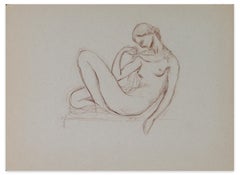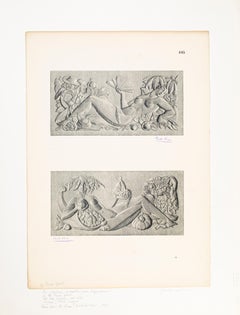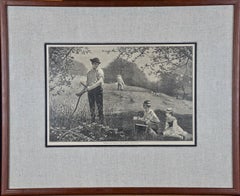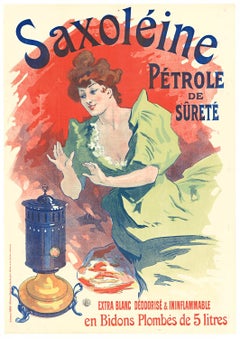Paul Vera Art
to
2
5
1
Overall Width
to
Overall Height
to
6
4
1
2
1
4
2
6
4
4
3
3
3
3
2
1
1
1
1
1
4
1
1
1
7
8,230
2,807
1,651
1,318
5
Artist: Paul Vera
Summer : Nude with a Fan - Original woodcut, Handsigned
By Paul Vera
Located in Paris, IDF
Paul VERA
Summer : Nude with a Fan, 1922
Original woodcut
Handsigned in pencil
Numbered /154
On vellum 32.5 x 25.5 cm (c. 13 x 10 in)
Bears the blind stamp ...
Category
1920s Art Deco Paul Vera Art
Materials
Woodcut
Tribute to Cezanne : The Bathers - Original wooodcut, Handsigned
By Paul Vera
Located in Paris, IDF
Paul VERA
Tribute to Cezanne : The Bathers, 1928
Original woodcut
Handsigned in pencil
Numbered /160
On vellum 32.5 x 25.5 cm (c. 13 x 10 in)
Bears the blin...
Category
1920s Art Deco Paul Vera Art
Materials
Woodcut
Laure, Model with Tall Eyes - Stone lithograph, 1930
By Paul Vera
Located in Paris, IDF
Paul VERA
Laure : Model with Tall Eyes, 1930
Original stone lithograph
Printed signature in the plate
On Arches vellum 28 x 22 cm (c. 11 x 9 inch)
Excellen...
Category
1930s Art Nouveau Paul Vera Art
Materials
Lithograph
Summer - Original Wooodcut, Handsigned
By Paul Vera
Located in Paris, IDF
Paul Vera
Summer, 1924
Original woodcut
Handsigned in pencil
Numbered /160
On vellum 25 x 33 cm (c. 9,8 x 12,9 in)
Edited for the 'Imagier de la Gravure sur Bois...
Category
1920s Modern Paul Vera Art
Materials
Woodcut
Lying Nude Woman - Original Pencil Drawing by Paul Véra - Early 20th Century
By Paul Vera
Located in Roma, IT
Lying Nude woman is a beautiful original drawing in brown pencil on paper, realized by the French artist Paul Véra (Paris, 1882 - Saint-Germain-en-Laye 1957)...
Category
Early 20th Century Paul Vera Art
Materials
Color Pencil
Les Saisons - Original Woodcut by Paul Vera - 1920s
By Paul Vera
Located in Roma, IT
Image dimensions: 13 x 27 cm.
Les Saisons is a beautiful original xylograph on tissue paper, realized by the French artist Paul Vera (Paris, 1882 - Saint-Ge...
Category
1920s Paul Vera Art
Materials
Woodcut
$234 Sale Price
25% Off
Related Items
Winslow Homer 19th Century Woodcut Engraving "Making Hay"
By Winslow Homer
Located in Alamo, CA
This Winslow Homer woodcut engraving entitled "Making Hay", was published in Harper's Weekly in the July 6, 1872 edition. It depicts a two men hand cutting high grass on a hill. The man in the foreground is looking at a young boy and a girl (presumably his children), who are sitting on the ground with a picnic basket.
This beautiful Homer woodcut engraving is presented in a brown wood frame and a light beige fabric mat with a black inner mat. The print is in excellent condition.
There are two other Homer woodcut engravings in identical frames and mats that are listed on 1stdibs. See LU117326148332 and LU117326148272. These would make a wonderful display grouping. A discount is available for the purchase of two or all three of these prints.
This Winslow Homer engraving...
Category
1870s American Impressionist Paul Vera Art
Materials
Engraving, Woodcut
Original "Saxoleine Petrole Surete" vintage stone lithograph 1900
By Jules Chéret
Located in Spokane, WA
Original Saxoleine Petrole de Surete, artist Jules Cheret.
Linen-backed turn-of-the-century original stone lithograph poster advertising Saxoleine, a lamp oil. The glow from this l...
Category
Early 1900s Art Nouveau Paul Vera Art
Materials
Lithograph
$3,519 Sale Price
20% Off
H 49.25 in W 24.75 in D 0.05 in
Max Weber Woodcut Print from "Primitives" Poetry Book Signed
By Max Weber
Located in Detroit, MI
ONE WEEK ONLY SALE
This woodcut print is an expressionist print on one of the poems from Max Weber's poetry collection "Primitives: Poems and Woodcuts". This work is signed in penci...
Category
1920s Expressionist Paul Vera Art
Materials
Woodcut
Original Metz vintage lithographic vintage travel poster
Located in Spokane, WA
Original vintage travel poster: METZ (France), artist: Alfred Pellon, signed A. Pellon. Size 34.75" x 36". Year: c 1906. Stone lithograph. ...
Category
Early 1900s Art Nouveau Paul Vera Art
Materials
Lithograph
$1,620
H 36 in W 34.75 in D 0.05 in
'Starry Night' — 1930s American Modernism
By Rockwell Kent
Located in Myrtle Beach, SC
Rockwell Kent, 'Starry Night' wood engraving, 1933, edition 1750, Burne Jones 103. Signed in pencil. A brilliant, black impression, on cream wove Japan paper; with margins (7/8 to 1 ...
Category
1930s American Modern Paul Vera Art
Materials
Woodcut
Stevan Dohanos, Backyard
By Stevan Dohanos
Located in New York, NY
Stevan Dohanos was an accomplished draftsman who work was widely known through the Saturday Evening Post. This print 'Backyard,' however, leaves aside the illustrative magazine work ...
Category
1930s American Modern Paul Vera Art
Materials
Woodcut
Frau in der Wanne (Woman in Tub) /// German Expressionism Schmidt-Rottluff Nude
By Karl Schmidt-Rottluff
Located in Saint Augustine, FL
Artist: Karl Schmidt-Rottluff (German, 1884-1976)
Title: "Frau in der Wanne (Woman in Tub)"
Series: Die Aktion
*Unsigned edition
Year: 1915
Medium: Original Woodcut Engraving on cream smooth wove paper
Limited edition: Unknown, (there was also a signed edition on laid paper with wider margins in an unknown edition size)
Printer: F.E. Haag, Melle, Hanover, Germany
Publisher: Verlag der Wochenschrift DIE AKTION, Berlin, Germany
Reference: "Das Graphische Werk Bis 1923" - Schapire No. 171, page 37; Söhn No. 40502
Framing: Recently framed in a contemporary gold moulding with 100% cotton rag matting and Artglass
Framed size: 16" x 13.25"
Sheet size: 11.5" x 8.75"
Image size: 10" x 7.25"
Condition: Faint UV staining to sheet and light toning at edges. It is otherwise a strong impression in excellent condition
Extremely rare
Notes:
Provenance: private collection - Kiel, Germany. Comes from the famous "Die Aktion" publication, Vol. 5, No. 13 published March 20th, 1915. Text on verso as issued. There is an example of this complete issue in the permanent collection of the Museum of Modern Art, New York, NY.
In 1911 Franz Pfemfert, a cantankerous critic of capitalism and Wilhelmine society, founded Die Aktion as a political and literary journal. In April of the following year, a new subtitle declared the journal a "weekly for politics, literature, and art." Although politics remained the priority, Die Aktion began featuring visual art coverage as well as original prints and illustrations.
Artist Max Oppenheimer...
Category
1910s Expressionist Paul Vera Art
Materials
Engraving, Woodcut
Art deco handcolored woodcut on paper - Walking black panther by Gaston Suisse
Located in Les Acacias GE, GE
Gaston Suisse (1896-1988)
Panthère noire dans les bambous, 1927
Gravure sur bois, sur papier Velin de Van Gelder.
Rehaussé aux lavis d’encre de Chine par l’artiste
Signé en bas à gauche et daté 1927 en bas à droite
Black panther in a forest of bamboos, 1927
A handcolored woodcut on Velin de Van Gelder paper
Signed and dated 1927
Bibliographie /Literature
Gaston Suisse, splendeur du laque art déco. Emmanuel Bréon. Somogy Éditions d'art, Paris 2013, reproduite page 105 (un autre exemplaire reproduit)
The artist made a wood engraving of which he made about twenty prints himself.
These proofs were not marketed as is, Gaston Suisse reworked each of the proofs using Indian ink washes in order to obtain different effects for each proof, which are thus unique original works.
Born in 1896 in a family of artists, his father Georges was a close friend of Siegfried Bing and a great lover of Japanese art and a bibliophile. He passed his taste for art to his son whom he often took to draw at the Botanic Garden . Around 1910, Gaston Suisse, who hasn't entered yet the artistic school, met Paul Jouve, then 18 years his elder, who was already famous.
In 1911, at the age of 17, he entered the National School of Decorative Art where he followed the teachings of Paul Renouard. Thanks to his knowledge and taste for the Japanese art, he chose lacquer painting as his specialty. His practice of this noble and demanding subject were so much appreciated that he was awarded with two gold medals in 1913 and 1914. Mobilized during the war , he joined the army and go in Salonika where he found his friend Jouve. In 1918, he finished his studies at the School of Applied Arts in order to perfect his training. He learned in particular the techniques of gilding and oxidation of metals. The first productions of Gaston Suisse, furniture and objects in lacquer with geometrical patterns, were an instant success and Suisse was appointed as member of Salon d'Automne in 1924, the very year of his first exhibition. Considered as an artist-decorator, his sincere and deep friendship with Jouve linked him in parallel with the groups of the animaliers of the Jardin des Plantes and became a close friend of Edouard-Marcel Sandoz. When travelling to Maghreb and Middle-East between 1923 and 1925, he produced numerous drawings representing antelopes, apes and fennec foxes...
Category
1920s Art Deco Paul Vera Art
Materials
India Ink, Woodcut
$4,321 Sale Price
44% Off
H 9.85 in W 17.92 in
Walter DuBois Richards, The Lobster Float
By Walter DuBois Richards
Located in New York, NY
Ohio-born Walter DuBois Richards (1907-2006) was educated at the Cleveland School of Art. He re-located to New York around 1933 where he had a successful career as a commercial artis...
Category
1930s American Modern Paul Vera Art
Materials
Woodcut
Dan Burne Jones, Affection
Located in New York, NY
Dan Burne Jones is widely know as the author of the Rockwell Kent print catalogue raisonne. It's so interesting to see that he is a gifted wood engraver as well. Jones's own prints a...
Category
1930s American Modern Paul Vera Art
Materials
Woodcut
Weib Vom Manne Begehrt (Woman Desired by Man) /// Max Pechstein Woodcut Modern
By Hermann Max Pechstein
Located in Saint Augustine, FL
Artist: Hermann Max Pechstein (German, 1881-1955)
Title: "Weib Vom Manne Begehrt (Woman Desired by Man)"
Portfolio: Deutsche Grapiker der Gegenwart (German Printmakers of Our Time)
*Unsigned edition
Year: 1919, (published 1920)
Medium: Original Woodcut Engraving on cream wove paper
Limited edition: 500, (there was also a signed and numbered edition of 30)
Printer: Unknown
Publisher: Klinkhardt & Biermann, Leipzig, Germany
Reference: "Das Graphische Werk Max Pechsteins" - Krüger No. 224; Fechter No. 157; Rifkind No. 2252; Söhn I, page 108-114
Sheet size: 12.75" x 9.5"
Image size: 9.88" x 6.25"
Condition: One small skillfully repaired tear lower left in margin. It is otherwise a strong impression in excellent condition
Notes:
Provenance: private collection - Kiel, Germany. Comes from the 1920 "Deutsche Grapiker der Gegenwart (German Printmakers of Our Time)" portfolio of fifteen lithographs, eight woodcuts, eight reproductions, and one lithographed cover by various artists. The artists who contributed to this portfolio were George Grosz, Ernst Barlach, Lovis Corinth, Richard Seewald, Heinrich Campendonk, Erich Heckel, Otto Mueller, Karl Schmidt-Rottluff, Lyonel Feininger, Conrad Felixmüller, Max Unold, Karl Caspar, Max Lieberman, René Beeh, Adolf Ferdinand Schinnerer, Ludwig Meidner, Max Beckmann, Richard Seewald, Käthe Kollwitz, August Gaul, Rudolf Grossman, Alfred Kubin, and Paul Klee. This very same work is within many permanent museum collections including the Museum of Modern Art, New York, NY.
"Deutsche Graphiker der Gegenwart (German Printmakers of Our Time)" brings together woodcuts, lithographs, and reproductions by thirty-one artists representing a cross-section of styles from Impressionism to Expressionism, uniting under a single cover works ranging from naturalistic self-portraits to left-wing political caricatures. It features works by artists associated with the Berlin Secession (an exhibiting society comprised primarily of German Impressionists), with Expressionist groups like the Brücke and Der Blaue Reiter, and with the political Novembergruppe, as well as artists like Max Beckmann who were not affliliated with any group.
In his introduction, art historian Kurt Pfister identified Expressionism as the leading force in German art at the time, while stressing the plurality of approaches to style and subject matter that the movement encompassed. Pfister emphasized the openness of German artists to foreign sources, and cited the importance of Paul Cézanne, Edvard Munch, and Pablo Picasso as well as Japanese, Indian, African, and Gothic art for the development of German art. There was a fifty-year difference in age between the oldest artist, Max Liebermann, and the youngest, Conrad Felixmüller, featured in the collection. The volume also included Lyonel Feininger, an American who had lived in Germany since 1896, as well as Austrian artists Oskar Kokoschka and Alfred Kubin.
Biography:
Pechstein was born in Zwickau, the son of a craftsman who worked in a textile mill. Early contact with the art of Vincent van Gogh stimulated Pechstein's development toward expressionism. After studying art first at the School of Applied Arts and then at the Royal Art Academy in Dresden, Pechstein met Erich Heckel and joined the art group Die Bru¨cke in 1906. He was the only member to have formal art training. Later in Berlin, he helped to found the Neue Sezession and gained recognition for his decorative and colorful paintings that were lent from the ideas of Van Gogh, Matisse, and the Fauves. His paintings eventually became more primitivist, incorporating thick black lines and angular figures.
From in 1933, Pechstein was vilified by the Nazis because of his art. A total of 326 of his paintings were removed from German museums. Sixteen of his works were displayed in the Entartete Kunst (Degenerate Art...
Category
1920s Expressionist Paul Vera Art
Materials
Engraving, Woodcut
$1,500 Sale Price
40% Off
H 12.75 in W 9.5 in
Madman's Drum (Brothel) — 'Story Without Words' Graphic Modernism
By Lynd Ward
Located in Myrtle Beach, SC
Lynd Ward, 'Madman's Drum, Plate 41', wood engraving, 1930, edition small. Signed in pencil. A fine, richly-inked impression, on off-white tissue-thin Japan paper; the full sheet with margins (1 5/8 to 2 1/2 inches); a small paper blemish in the upper right margin, away from the image, otherwise in excellent condition. A scarce, artist-printed, hand-signed proof impression before the published edition. Matted to museum standards, unframed.
Image size 5 1/2 x 3 3/4 inches (140 x 95 mm); sheet size 9 5/8 x 7 1/8 inches (244 x 181 mm).
From Lynd Ward’s book of illustrations without words, 'Madman’s Drum', Jonathan Cape and Harrison Smith, New York, 1930.
Reproduced in 'Storyteller Without Words, the Wood Engravings of Lynd Ward', Harry N. Abrams, New York, 1974.
ABOUT THE ARTIST
Lynd Ward is acknowledged as one of America’s foremost wood engravers and book illustrators of the first half of the twentieth century. His innovative use of narrative printmaking as a stand-alone storytelling vehicle was uniquely successful in reaching a broad audience. The powerful psychological intensity of his work, celebrated for its dynamic design, technical precision, and compelling dramatic content, finds resonance in the literature of Poe, Melville, and Hawthorne. Like these classic American writers, Ward was concerned with the themes of man’s inner struggles and the role of the subconscious in determining his destiny. An artist of social conscience during the Great Depression and World War II, he infused his graphic images with his unique brand of social realism, deftly portraying the problems that challenged the ideals of American society.
The son of a Methodist preacher, Lynd Ward, moved from Chicago to Massachusetts at an early age. He graduated from the Teachers College of Columbia University, New York, in 1926, where he studied illustration and graphic arts. He married May Yonge McNeer in 1936 and left for Europe for their honeymoon in Eastern Europe. After four months, they settled in Leipzig, where Ward studied at the National Academy of Graphic Arts and Bookmaking. Inspired by Belgian expressionist artist Frans Masereel's graphic novel ‘The Sun,’ and another graphic novel by the German artist Otto Nückel, ‘Destiny,’ he determined to create his own "wordless" novel. Upon his return to America, Ward completed his first book, ‘God's Man: A Novel in Woodcuts,’ published in 1929. ‘Gods’ Man’ was a great success for its author and publisher and was reprinted four times in 1930, including a British edition. This book and several which followed it, ‘Madman’s Drum,’ 1930, ‘Wild Pilgrimage...
Category
1930s American Modern Paul Vera Art
Materials
Woodcut
$650
H 5.07 in W 3 in D 0.01 in
Previously Available Items
Summer - Original Wooodcut, Handsigned
By Paul Vera
Located in Paris, IDF
Paul Vera
Summer, 1924
Original woodcut
Handsigned in pencil
Numbered /160
On vellum 25 x 33 cm (c. 9,8 x 12,9 in)
Edited for the 'Imagier de la Gravure sur Bois' (5th year) and be...
Category
1920s Modern Paul Vera Art
Materials
Woodcut
Summer : Nude with a Fan - Original woodcut, Handsigned
By Paul Vera
Located in Paris, IDF
Paul VERA
Summer : Nude with a Fan, 1922
Original woodcut
Handsigned in pencil
Numbered /154
On vellum 32.5 x 25.5 cm (c. 13 x 10 in)
Bears the blind stamp ...
Category
1920s Art Deco Paul Vera Art
Materials
Woodcut
Paul Vera art for sale on 1stDibs.
Find a wide variety of authentic Paul Vera art available for sale on 1stDibs. You can also browse by medium to find art by Paul Vera in woodcut print, color pencil, lithograph and more. Much of the original work by this artist or collective was created during the 20th century and is mostly associated with the Art Deco style. Not every interior allows for large Paul Vera art, so small editions measuring 9 inches across are available. Customers who are interested in this artist might also find the work of Rene Vincent, Roger Broders, and Maurice Dufrêne. Paul Vera art prices can differ depending upon medium, time period and other attributes. On 1stDibs, the price for these items starts at $187 and tops out at $333, while the average work can sell for $248.



